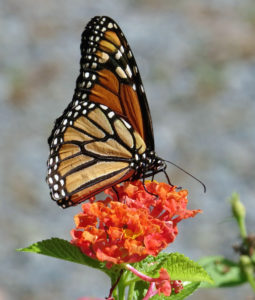Submitted by Marlene A. Condon
The Monarch butterfly makes the longest insect migration in the world, even though it weighs, on average, less than a paper clip. Traveling to Mexico under its own wing power from Canada and the United States east of the Rocky Mountains, it might fly as many as 2,500 miles to get there.
Once taken for granted by hawk watchers as fellow travelers of migrating hawks, the orange and black butterflies started to become fewer and far less seen as we entered the 21st century. By 2012 the population of this species took a precipitous turn for the worse.
The late Lincoln Brower, a professor and Monarch expert at Sweet Briar College, worked hard to bring the butterflies’ plight to the public’s attention. He pointed out that one of the major problems for this insect’s decline in numbers was the loss of its caterpillar food plant, and he urged folks to plant milkweed. It’s apparent that they responded to his plea.
An abundance of these butterflies has been spotted here, there, and everywhere this fall, making for a phenomenal comeback. At hawk watch sites (locations known to be good for viewing migrating hawks) in Virginia, Monarch after Monarch has been seen winging its way south.
On Afton Mountain, site of my local hawk watch, Sept. 26 turned out to be a day of uncountable numbers. They could be seen flying nonstop, high and low and all around at every level. The site’s official report for that day included the note that 1,500+ Monarchs had passed by.
 At every hawk watch site in Virginia, from the northeast to the southwest, as well as on the Eastern Shore, hawk watchers have spotted and counted Monarch butterflies on non-rainy days, attesting to the profusion of these insects heading south. This abundance of Monarchs signifies that an abundance of caterpillars fed upon an abundance of milkweed plants during this year’s breeding season.
At every hawk watch site in Virginia, from the northeast to the southwest, as well as on the Eastern Shore, hawk watchers have spotted and counted Monarch butterflies on non-rainy days, attesting to the profusion of these insects heading south. This abundance of Monarchs signifies that an abundance of caterpillars fed upon an abundance of milkweed plants during this year’s breeding season.
The only way to account for such a spectacular return of these insects is to give credit where credit is due – to the many folks who planted milkweed, whether they did so individually in their own gardens or as part of a group effort on public lands. Even the Virginia Department of Transportation assisted the butterflies by leaving many road medians unmown this summer, where common milkweed sprouted and undoubtedly fed Monarch caterpillars.
As my friend David White told me, the “Monarch numbers are delightfully inspiring and hopeful.” But please note: This is not the end of the story. For the Monarchs to make it to their overwintering site in the mountains of Mexico, they must obtain nourishment along the way. It takes energy to fly, which they obtain from nectar-producing flowers.
If you did not grow late-blooming plants this year, you can plan now to grow some next year. Goldenrod suits the bill perfectly, as does zinnia – and don’t forget the milkweed, of course!
If you find growing shrubs to be easier than growing flowers, Glossy Abelia is a superb choice. It begins blooming in spring and continues till frost if it receives full sun throughout the fall, providing nectar for hummingbirds in addition to many species of butterflies and moths.
If you only have room for potted plants, not to worry! They can also assist Monarchs to reach their destination in good health. One of my favorites is Lantana camara, a member of the verbena family. It makes lots of nectar-filled blooms all summer till frost, feeding hummingbirds, bees, butterflies and moths.
The Monarchs that get to Mexico must survive the winter in large numbers before we can say the species is truly recovering. In fact, the wintering numbers fell the past two years.
During the winter of 1996-97, the butterflies covered approximately 44 acres of forest. In 2017-18, that number was only about six acres, which was down from the 2016-17 observation of approximately seven acres. Although the population sometimes goes up, as it has this year, Monarch numbers have generally continued to decline.
Nonetheless, the astounding population increase this year is a wonderful sign for future breeding success. It demonstrates that people care and that they are willing to do what needs to be done to help maintain our unique, and thus very special, Monarch migration spectacle.
Brower was willing to personally advocate for the species he spent decades studying and admiring, which is unusual among scientists who generally do not want to be seen as activists. Jennifer Jowdy, a hawk watcher I met this year from Charlottesville, told me that she liked to think that the Monarchs were “rising up, in honor of Lincoln Brower.” It’s a wonderful sentiment about a spirited researcher who brought the plight of the Monarch to our attention and helped move people to take action. The success of their efforts has been easily visible and is to be highly commended.




